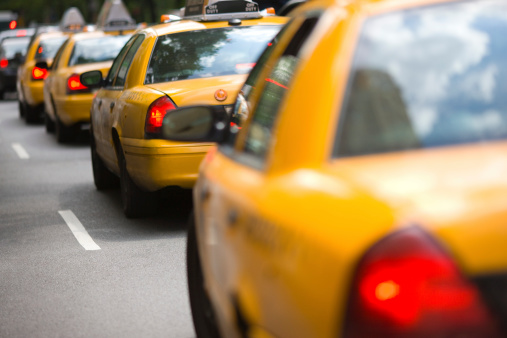
Ridesharing companies like Uber and Lyft pose challenges for local regulators.
Ask average urban-dwellers about their experiences with taxis and there is a good chance you will hear a lot of complaints: long waits in bad weather, futile attempts to get a cab during rush hour, the frustration of finding a taxi only to have someone else slip into the backseat at the last second. In an era where smartphone users can call up a list of every restaurant within walking distance or conduct bank transactions with a few taps on a screen, it was inevitable that ride-seekers would start to wonder: “Is there an app for cabs?”
In stepped ridesharing companies like Uber and Lyft, which bill themselves as platforms for connecting ride-seekers and drivers via free smartphone apps. Customers can set their location on a map, schedule a pickup from a nearby driver, and track their car as it approaches. Credit card information is stored in the app and users are automatically charged when they get a ride. Some companies offer multiple ridesharing options. For example, Uber customers can choose between a high-end town car, a black SUV, or the newer UberX option, which offers cheaper rates for rides in non-luxury cars.
Many users praise Uber and Lyft as convenient and reliable. Widespread demand for Uber, in particular, has helped the company expand to hundreds of U.S. cities and 46 countries. Goldman Sachs and other high-profile investors have backed Uber, and, five years after launching, the company is now valued at about $17 billion.
However, not everyone is quite so enamored with ridesharing. Taxi companies and industry representatives have pushed to regulate Uber and Lyft like traditional car services. They argue that ridesharing companies hold an unfair competitive advantage because they do not have to incur the costs of complying with regulations imposed on taxis.
Opponents of ridesharing also question its safety, with Uber coming under particularly strong criticism after some high-profile incidents with drivers. The Taxicab, Limousine & Paratransit Association‘s “Who’s Driving You” initiative calls ridesharing a “serious threat to public safety.” Even some states have warned residents that ridesharing may pose risks.
Uber insists that its services are safe, and argues that the company should not be classified (or regulated) as a transportation service provider. Instead, Uber calls itself a technology company, and says the service it delivers is not the ride but the platform for connecting driver and rider. To distinguish itself from taxi services, the company points to the fact that it does not hire drivers or own vehicles. Drivers are independent contractors who provide transportation in their personal vehicles.
Uber has dedicated considerable resources to painting cab companies as hostile to innovation, and this narrative has quickly gained traction in the media. Often commentators have framed the issue as free market vs. government, innovation vs. heavy-handed regulation.
Although Uber takes pains to distance itself from the “transportation or logistics services” industry, the nature of its services – whether classified as technology or car service – have had significant effects on taxi companies in some areas. A recent BBC report points to San Francisco where, in a two-and-a-half year period, taxi rides apparently dropped by 65%. Taxi drivers facing the reality or even the prospect of declining wages argue that not regulating Uber gives the company an unfair competitive edge. The issue, professional cabbies say, is not that they are opposed to competition, but that regulations need to create a level playing field.
In light of this, it is not surprising that regulators charged with navigating the ride-sharing terrain have found the issues complex and highly charged. Not only must regulators balance the need for oversight with the goal of keeping markets open to new enterprises, but they also have to deal with questions of liability and insurance.
Cities have approached this in different ways, with some – like Annapolis, Maryland – opting to regulate ridesharing under the same rules as taxis, while others – like New Orleans – have banned the practice altogether.
Elsewhere, regulators have struggled, or are still struggling, to cope with ridesharing and the sharing economy more generally. A recent deal between Uber, Lyft, and Virginia officials was reached only after “months of escalating tension between the state and the two companies, which had vowed to continue operating in the commonwealth despite a June cease and desist order.”
In New York, the Attorney General who previously sought a restraining order against Lyft wrote a letter to the New York City Taxi and Limousine Commission asking it to revise a proposed rule that would restrict the operations of ridesharing companies. And the District of Columbia City Council recently passed legislation that would allow Uber and Lyft to operate if they agreed to certain conditions (including background checks and minimum insurance requirements), but it did so over loud protests from teamsters and cabbies.
However, other states and cities seem to have come to terms with ridesharing. Colorado recently passed legislation creating a new business category to accommodate ridesharing companies. Under that law, Uber is defined and regulated as a “transportation network company” (TNC). The Minneapolis City Council likewise recognizes TNCs as being different than taxis and therefore subject to different licensing requirements.
Battles over Uber and other ridesharing companies continue to brew in cities around the world, with Philadelphia and Las Vegas likely to become hot spots in the next several months. However, some industry observers point to places like Colorado and Minneapolis as signs that that ridesharing organizations, taxi companies, and regulators are not doomed to lock horns forever.



